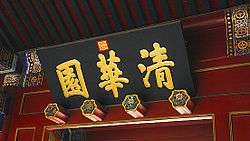History of Tsinghua University
The history of Tsinghua University spans over a century since it was founded in 1911. The school is located on the site of Tsinghua Garden in Beijing, the former residence of Yinzhi, the third son of the Kangxi Emperor of the Qing dynasty.
In 1909, the indemnity payment to the United States from the Boxer Protocol was reduced by US$10.8 million by Theodore Roosevelt's administration. The Qing imperial court used the difference to create the Boxer Indemnity Scholarship Programme and established the China Institute along with a preparatory school. The school was later renamed Tsinghua School and expanded in 1925 with the addition of a college department. It was officially chartered as a national university by the Nationalist Government of the Republic of China in 1928. After the onset of Second Sino-Japanese War, Tsinghua was relocated to Changsha along with Peking University and Nankai University to form National Changsha Provisional University. The combined school was relocated to Kunming in 1938 and renamed as National Southwest Associated University.
In 1946, Tsinghua University was restored and resumed its operation after the school was relocated back to Tsinghua Garden. After a series of education policy reform beginning in 1952, Tsinghua transformed into the top institute dedicated to science and technology in National Key Universities. In the aftermath of the Cultural Revolution in 1976, the school was elevated again through the introduction of Project 211 and Project 985 that aimed to improve the research standard of higher education in China.
Background

The history of Tsinghua originated in the Boxer Protocol signed in 1901. The Qing dynasty had to pay war reparations amounting to US$333 million with four percent annual interest rate in taels of fine silver to the Eight-Nation Alliance, in which the United States had a share of US$24,440,778.81. With difficulties in settling the debt, the Chinese Ministry of Foreign Affairs instructed the Chinese ambassador Liang Cheng to negotiate with United States. On 5 December, Liang had the first meeting with United States Secretary of State John Hay, in which Hay proposed that the reparations exceeded the original demand from the United States, and the reduction of payment was settled.[1] With approval from the United States Congress, President Theodore Roosevelt authorised the further reduction of the reparation down to US$13,655,492.69. The remaining difference was to be returned to China, gradually starting in January 1909 for educational programmes, and to create scholarship programmes for Chinese students to study in the United States.[2][3] To honour Theodore Roosevelt for his contributions to the founding of Tsinghua University, a gymnasium on the Tsinghua campus was named Roosevelt Memorial Gynasium.[4]
On 11 July 1908, the document for reduction of reparation was delivered to the Qing imperial court by ambassador William Woodville Rockhill. Prince Qing responded to the United States government as follows:
We appreciate your President's sincerity in encouraging our students to enrol in American schools and seek higher education. In the light of the success that American-style education has brought to our country, the Government of the Great Qing Empire is faithfully committed to annually sending students to be educated in your schools.[5]
Tang Shaoyi was dispatched to the United States to deliver the official letter from the Qing imperial court. The letter says:[2]
We use the year of reduction in reparation as a point of reference. In the previous four years, the Qing Dynasty has sent 100 students (to the United States) annually. At the end of four years, there will be 400 students from our country in the United States. From the fifth year to the year when we finish paying reparations, we will send at least 50 students every year (to the United States).[6]

The United States government begin to remit the difference in 1909. In May, Tenney Charles Daniel was assigned to represent the United States government in the study programme. The selection of students was finalised after a series of discussion in June, and the proposal received the imperial approval on 10 July. The office for the study programme was officially set up on 17 July.[Note 1] On 25 August, Zhou Ziqi[Note 2] and Tang Guo'an were appointed to the board of directors to run the office operations.[7] Tsinghua Garden was transferred to the study programme office to establish the preparatory school.[8]

Notes
- ↑ 有“游美学务处”建立于“6月或7月”、“六月初四日”等说法,但根据《游美学务处为报宣统元年全年经费事致外务部呈文》,应为“六月初一”,即1909年7月17日。
- ↑ 周自齐在1909年初授外务部右参议,署(“代理”之意)左参议,5月补任左参议,8月署右丞,不久改为署左丞。8月25日,兼任学部丞参上行走并出任游美学务处总办。此时,其职位有四:外务部署左丞、外务部左参议、学部丞参上行走、游美学务处总办,官品为候补三四品京堂。后于1922年代行中华民国北京政府总统。
References
- ↑ 仰之 (2009-03-25). "1904年12月5日——中美外交官就美国退还庚子赔款谈判的起始日". 紫苑网. Retrieved 2010-12-13.
- 1 2 国立清华大学. 校史:北京清华时期 (in Chinese). 国立清华大学官网. Retrieved 2010-11-05.
- ↑ 校史概略. 清华周刊 (in Chinese) (13-14): 1–3. 1934.
- ↑ 兰妮 (2005-03-24). 从建筑回想清华旧时光 (再版). 法制晚报 (in Chinese).
- ↑ 體會新近貴國總統希望鼓勵我國學生赴美入學校及求高深學問之誠意,並有鑒於以往貴國教育對於我國之成效,大清帝國政府謹誠懇表示此後當按年派送學生到貴國承受教育。
- ↑ 從賠款退還之年起,前四年清朝將次第派送100學生;迨4年終局,我國將有400學生在美,從第5年起,直至賠款完畢之年,每年至少派送50名學生。
- ↑ 孟凡茂 (2010-10-18). "兼职总办 未任监督——谈谈清华学堂的创始人周自齐兼及清华学堂创办经过". 清华校友网. Retrieved 2010-12-13.
- ↑ 黄延复 (2005). 清华园风物志(M) (in Chinese). 北京: 清华大学出版社. pp. 20–23. ISBN 978-730-21155-4-0.
External links
| Wikimedia Commons has media related to History of Tsinghua University. |
| Wikisource has 外务部为拟定收还庚子赔款遣派学生赴美办法大纲事奏折:
外务部为何日移交清华园地亩兴筑游美肄业馆事致内务府咨文 |